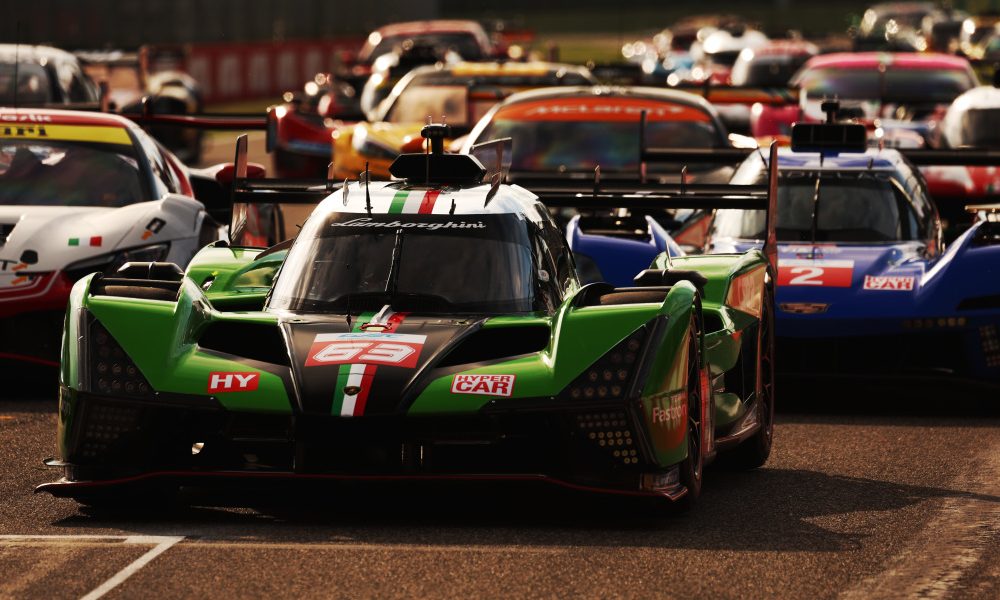Ahead of the FIA WEC weekend in Imola, reports emerged that a new rule mandating two cars for each Hypercar manufacturer from the 2025 season onwards was under consideration.
RACER believes a vote on this is looming, leaving the current and future single-car OEMs in the FIA WEC working hard on solutions should they be required to expand their programs going forward to continue racing in the championship, and crucially the Le Mans 24 Hours.
If it is approved by the World Motor Sport Council, it would have an impact on three current Hypercar factories in the WEC: Lamborghini, Isotta Fraschini, and Cadillac, as well as Aston Martin, which originally planned to join the field next year with “at least” a single Valkyrie entered by Heart of Racing.
The good news off the bat, RACER understands, is that all of the OEMs concerned should be able to fulfil this requirement in time for next season. And any associated IMSA programs being run alongside them don’t appear to be under threat at this point either.
Starting with Lamborghini, Iron Lynx team principal Andrea Piccini told RACER during the Imola weekend that if the rule comes into force it “will run two cars”.
“This is a proper partnership (between Iron Lynx and Lamborghini) and any decision made is one we take together,” he said. “We are already thinking and talking about next year. And the WEC is talking about rules for next year, whether it might be mandatory to run two cars. If that is the case we are ready to do it.”
Crucially, Piccini explained that a second car in WEC wouldn’t necessarily come at the expense of its IMSA GTP program, which he says is very important to Lamborghini.
“It’s too early to say, but I think the idea would be in that case to run two (in WEC) and one (in IMSA),” he said. “It’s not easy, we are working on it. But if WEC says we need to run two cars, we will run two cars.”
Cadillac meanwhile, should be ready as it is poised to expand its V-Series.R program in the WEC regardless of the new rule being put in place. This follows its decision, which was first revealed by RACER, to cut ties with Ganassi Racing on both sides of the Atlantic at the end of the current season.

The process of selecting a new partner team for the WEC is well underway and in its final stages. The ultimate decision, plus the subsequent contract signing is not expected until sometime after the Le Mans 24 Hours.
As for Isotta Fraschini, while it is currently navigating the challenges of getting its single-car effort with the Tipo 6-C and partner team Duqueine up to speed, it is known to have ambitions to race with two cars. Ahead of the 2024 FIA WEC entry list reveal Isotta was understood to have made moves to run two cars, before being granted a single space on the grid for the season due to the entry being capped at 37.
Aston Martin is the final piece to this puzzle with its highly-anticipated Valkyrie LMH program that’s set to debut in the WEC and IMSA in 2025.
On the record, when approached for comment on its ability to field two cars next season, Aston Martin said simply:
“We are aware of the rule, we are keeping an eye on it, but we don’t comment on speculation.”
What is clear is that Aston Martin and Heart of Racing’s ambitions to race in both IMSA and the WEC off the bat will make it a hard task to increase its car count in Year 1.
There appear to be four scenarios to consider.
The first is that Heart of Racing operates two Valkyries next season in the WEC and races in IMSA with a single car as planned, though there have been no suggestions made to RACER in background conversations that this is on the cards.
The second is that Heart of Racing runs two cars in the WEC and zero in IMSA. Again, there appears to be no appetite for this. An IMSA GTP program for the Valkyrie is known to be an important part of Gabe Newell and Ian James’ plans.
Third is that Aston Martin pulls the plug on its WEC effort altogether because it cannot or will not commit to a two-car program. This is another highly unlikely scenario, given the amount of resources being poured into the Valkyrie project and the importance placed on competing in the Le Mans 24 Hours.
In conversation with RACER, senior paddock sources appear confident that Aston Martin has a solution and would fulfil the two-car mandate if it is in place. Does that then, leave the potential for a second Valkyrie, operated by a second team, as the most likely solution? Could this be the answer?
For next year, with changes expected to come concerning the look and shape of the current set of teams racing in Hypercar, the grid size is also believed to be increasing to 40 plus.
The question of garage and paddock space at the circuits on the calendar is always a talking point, and there are likely to be some real pinch points going forward as the entry grows. Last weekend in Imola, as an example, multiple LMGT3 teams had to house their cars nose-to-tail in a single garage as a result of the limitations of the pit lane.
Either way, there appears to be no suggestion that factories will walk away if this new rule comes into play. Indeed, the bigger question may well surround the impact it has on the customer marketplace…
